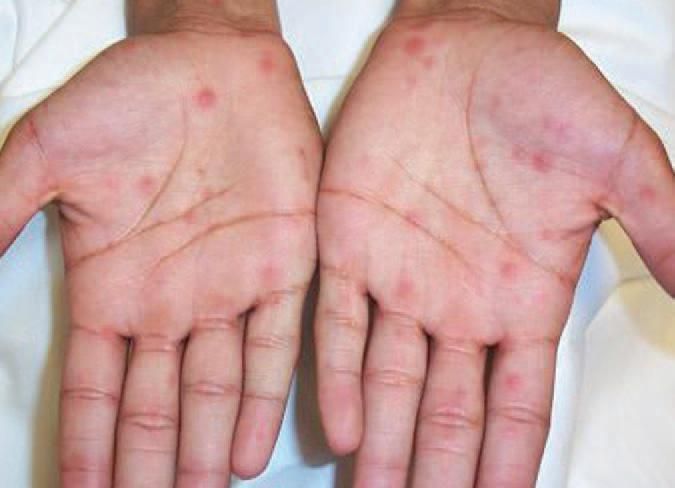Secondary Syphilis Palmar Lesions
The patient denied use of new skin products, detergents, or medications. He had no pets. There was no history of recent travel, and the patient was not aware of any arthropod bites. None of his family members had a similar rash. The patient was sexually active and had had 3 partners in the past 2 years; he said he always used condoms. His history was otherwise unremarkable, as were physical findings.

FigureThis rash on a teenage boy's palms began on his hands and spread to his torso and upper and lower extremities over several days. He had no pain or pruritus. Two weeks before the lesions appeared, he had experienced fatigue, fever, and myalgia of 1 week's duration.
The patient denied use of new skin products, detergents, or medications. He had no pets. There was no history of recent travel, and the patient was not aware of any arthropod bites. None of his family members had a similar rash. The patient was sexually active and had had 3 partners in the past 2 years; he said he always used condoms. His history was otherwise unremarkable, as were physical findings.
The coppery "ham-colored" palmar lesions and accompanying maculopapular rash on the trunk and extremities are characteristic of secondary syphilis. The lesions tend to be polymorphic and are often preceded by systemic symptoms, such as headache, sore throat, myalgia, and fatigue. Generalized adenopathy and hepatosplenomegaly may also be present. Other significant cutaneous manifestations of secondary syphilis include irregular or "moth-eaten" alopecia of the beard, scalp, or eyelashes, and condylomata, which may affect any mucous membrane.
Sole and palmar lesions occur in most patients with secondary syphilis. This type of rash is also typical of erythema multiforme, Rocky Mountain spotted fever, hand-foot-and-mouth disease, tinea manum, meningococcal sepsis, and scarlet fever. The trunk and extremity rash of secondary syphilis can be confused with that of pityriasis rosea, lichen planus, guttate psoriasis, tinea versicolor, and drug and viral eruptions.
The incidence of both acquired and congenital syphilis has risen concurrently with the increase of HIV/AIDS cases in the United States.1 In 2005, half of all reported cases of primary and secondary syphilis occurred in 19 of 701 counties and in 2 cities (Baltimore and Washington, DC). The male-to-female rate ratio for syphilis has risen from 1.2 in 1996 to 5.7 in 2005; this correlates with the increased rate of syphilis among men who have sex with men.2
The chancre of primary syphilis is painless and often accompanied by only mild regional lymphadenopathy; frequently, it is undetected, as was the case with this patient. The chancre typically occurs 2 to 6 weeks after sexual exposure and usually heals within 4 to 6 weeks. Un-treated spirochetemia leads to secondary syphilis. Serosanguinous material collected from an unroofed moist lesion may be examined under dark-field microscopy for Treponema pallidum.
Because our patient had neither a chancre nor mucosal lesions, serological testing was performed. Results of a rapid plasma reagin test were positive (titer of 1:64). Positive findings should be confirmed with the fluorescent treponemal antibody-absorption test, which detects antigens specific to T pallidum.
Testing for HIV infection is indicated for patients with a suspected or confirmed diagnosis of syphilis. The high rate of HIV coinfection is attributed in part to the ulcerative nature of primary syphilis, which facilitates transmission of HIV. Patients should also be tested for other sexually transmitted diseases, such as gonorrhea, chlamydia infection, and hepatitis B and C. Our patient tested positive for HIV infection.
In all patients with HIV infection and syphilis, a lumbar puncture is recommended to rule out asymptomatic neurosyphilis, which may be more common among patients with HIV infection.3,4 This patient refused this test. He was treated with 3 weekly injections of 2.4 million units of penicillin G benzathine and aggressive follow-up, because of the slightly higher treatment failure rate among patients with HIV infection. He was also referred to an adolescent HIV clinic for initiation of antiretroviral therapy and support.
References:
- American Academy of Pediatrics. Syphilis. In: Pickering LK, Baker CJ, Long SS, McMillan JA, eds. Red Book: 2003 Report of the Committee on Infectious Diseases. 26th ed. Elk Grove Village, Ill: American Academy of Pediatrics; 2003:596.
- Center for Disease Control and Prevention. Sexually Transmitted Disease Syphilis Surveillance. Annual Report 2005. Available at: http://www.cdc.gov/std/Syphilis2005/SyphSurvSupp2005Short.pdf. Accessed January 4, 2008.
- Lukehart S. Syphilis. In: Braunwald E, Fauci AS, Kasper DL, et al, eds. Harrison's Principles of Internal Medicine. 15th ed. New York: McGraw-Hill; 2001:1050.
- Hook E III. Syphilis. In: Goldman L, Ausiello D, eds. Cecil Textbook of Medicine. 22nd ed. Philadelphia: WB Saunders; 2004:1928.
Recognize & Refer: Hemangiomas in pediatrics
July 17th 2019Contemporary Pediatrics sits down exclusively with Sheila Fallon Friedlander, MD, a professor dermatology and pediatrics, to discuss the one key condition for which she believes community pediatricians should be especially aware-hemangiomas.